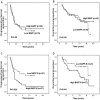Expression of BAFF and BAFF-R in follicular lymphoma: correlation with clinicopathologic characteristics and survival outcomes
- PMID: 23272079
- PMCID: PMC3521766
- DOI: 10.1371/journal.pone.0050936
Expression of BAFF and BAFF-R in follicular lymphoma: correlation with clinicopathologic characteristics and survival outcomes
Abstract
Background: B-cell activation factor (BAFF) and BAFF-receptor (BAFF-R) play crucial roles in the viability and proliferation of malignant lymphoma cells. Limited information exists regarding expression profiles and the prognostic role of BAFF and BAFF-R in follicular lymphoma (FL). We sought to determine the expression profiles of BAFF and BAFF-R in FL and to evaluate the correlation of BAFF and BAFF-R expression with clinicopathologic characteristics and outcome of FL. Correlation between expression levels of BAFF detected by immunohistochemical (IHC) and serum levels of BAFF was also evaluated.
Methods: Paraffin-embedded specimens from 115 patients were immunohistochemically examined for BAFF and BAFF-R expression. Expression levels were dichotomized into low versus high categories based on immunostaining intensity. The correlation of BAFF and BAFF-R expression with clinicopathologic characteristics and patient outcome was assessed. Serum levels of BAFF in 35 of the 115 patients with IHC data were measured by Enzyme-linked Immunosorbent assay (ELISA).
Results: BAFF and BAFF-R were expressed in 88.7% (102/115) and 87.8% (101/115) of the cases, respectively. BAFF expression was significantly correlated with only one clinicopathologic feature: Ann Arbor stage. No significant correlation was found between expression levels of BAFF detected by IHC and serum levels of BAFF detected by ELISA. High expression of BAFF-R, but not BAFF, was significantly correlated with inferior progression-free survival (PFS; P = 0.013) and overall survival (OS; P = 0.03). High expression of BAFF-R, bulky disease, and elevated lactate dehydrogenase were correlated with inferior PFS and OS in multivariate analysis. A prognostic scoring system incorporating these 3 risk factors identified 3 distinct prognostic groups with 5-year PFS of 59.4%, 41.9%, and 10.7% and OS of 91.3%, 79.7%, and 45.8%, respectively.
Conclusions: Most patients with FL variably express BAFF and BAFF-R. High expression of BAFF-R, but not BAFF, may be an independent risk factor for PFS and OS in FL.
Conflict of interest statement
Figures





Similar articles
-
Expression of BAFF-R, but not BAFF, is an independent prognostic factor in diffuse large B-cell lymphoma patients treated with R-CHOP.Ann Hematol. 2015 Nov;94(11):1865-73. doi: 10.1007/s00277-015-2490-0. Epub 2015 Sep 2. Ann Hematol. 2015. PMID: 26327569
-
High APRIL but not BAFF serum levels are associated with poor outcome in patients with follicular lymphoma.Ann Hematol. 2015 Jan;94(1):79-88. doi: 10.1007/s00277-014-2173-2. Epub 2014 Aug 22. Ann Hematol. 2015. PMID: 25146008
-
Expression of BAFF-R and TACI in reactive lymphoid tissues and B-cell lymphomas.Histopathology. 2009 Jan;54(2):221-32. doi: 10.1111/j.1365-2559.2008.03203.x. Histopathology. 2009. PMID: 19207947
-
BAFF-R is expressed on B-cell lymphomas depending on their origin, and is related to proliferation index of nodal diffuse large B-cell lymphomas.J Clin Exp Hematop. 2010;50(2):121-7. doi: 10.3960/jslrt.50.121. J Clin Exp Hematop. 2010. PMID: 21123970
-
Role of BAFF/BAFF-R axis in B-cell non-Hodgkin lymphoma.Crit Rev Oncol Hematol. 2014 Aug;91(2):113-22. doi: 10.1016/j.critrevonc.2014.02.004. Epub 2014 Feb 23. Crit Rev Oncol Hematol. 2014. PMID: 24629840 Review.
Cited by
-
Total peroxiredoxin expression is associated with survival in patients with follicular lymphoma.Virchows Arch. 2016 May;468(5):623-30. doi: 10.1007/s00428-016-1920-2. Epub 2016 Mar 16. Virchows Arch. 2016. PMID: 26983700
-
A novel VHH antibody targeting the B cell-activating factor for B-cell lymphoma.Int J Mol Sci. 2014 May 28;15(6):9481-96. doi: 10.3390/ijms15069481. Int J Mol Sci. 2014. PMID: 24879522 Free PMC article.
-
Molecular Biomarkers in Prediction of High-Grade Transformation and Outcome in Patients with Follicular Lymphoma: A Comprehensive Systemic Review.Int J Mol Sci. 2024 Oct 17;25(20):11179. doi: 10.3390/ijms252011179. Int J Mol Sci. 2024. PMID: 39456961 Free PMC article.
-
Generation of a humanized afucosylated BAFF-R antibody with broad activity against human B-cell malignancies.Blood Adv. 2023 Mar 28;7(6):918-932. doi: 10.1182/bloodadvances.2022008560. Blood Adv. 2023. PMID: 36469551 Free PMC article.
-
In Like a Lamb; Out Like a Lion: Marching CAR T Cells Toward Enhanced Efficacy in B-ALL.Mol Cancer Ther. 2021 Jul;20(7):1223-1233. doi: 10.1158/1535-7163.MCT-20-1089. Epub 2021 Apr 26. Mol Cancer Ther. 2021. PMID: 33903140 Free PMC article. Review.
References
-
- Armitage JO, Weisenburger DD (1998) New approach to classifying non-Hodgkin's lymphomas: clinical features of the major histologic subtypes. Non-Hodgkin's Lymphoma Classification Project. J Clin Oncol 16: 2780–2795. - PubMed
-
- Biagi JJ, Seymour JF (2002) Insights into the molecular pathogenesis of follicular lymphoma arising from analysis of geographic variation. Blood 99: 4265–4275. - PubMed
-
- Solal-Celigny P, Roy P, Colombat P, White J, Armitage JO, et al. (2004) Follicular lymphoma international prognostic index. Blood 104: 1258–1265. - PubMed
-
- Federico M, Bellei M, Marcheselli L, Luminari S, Lopez-Guillermo A, et al. (2009) Follicular lymphoma international prognostic index 2: a new prognostic index for follicular lymphoma developed by the international follicular lymphoma prognostic factor project. J Clin Oncol 27: 4555–4562. - PubMed
-
- Moore PA, Belvedere O, Orr A, Pieri K, LaFleur DW, et al. (1999) BLyS: member of the tumor necrosis factor family and B lymphocyte stimulator. Science 285: 260–263. - PubMed
Publication types
MeSH terms
Substances
LinkOut - more resources
Full Text Sources

